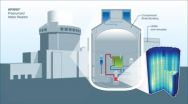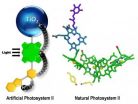(Press-News.org) OAK RIDGE, Tenn., Feb. 18, 2014 — Scientists and engineers developing more accurate approaches to analyzing nuclear power reactors have successfully tested a new suite of computer codes that closely model "neutronics" — the behavior of neutrons in a reactor core.
Technical staff at Westinghouse Electric Company, LLC, supported by the research team at the Consortium for Advanced Simulation of Light Water Reactors (CASL), used the Virtual Environment for Reactor Applications core simulator (VERA-CS) to analyze its AP1000 advanced pressurized water reactor (PWR). The testing focused on modeling the startup conditions of the AP1000 plant design.
"In our experience with VERA-CS, we have been impressed by its accuracy in reproducing past reactor startup measurements. These results give us confidence that VERA-CS can be used to anticipate the conditions that will occur during the AP1000 reactor startup operations," said Bob Oelrich, manager of PWR Core Methods at Westinghouse. "This new modeling capability will allow designers to obtain higher-fidelity power distribution predictions in a reactor core and ultimately further improve reactor performance."
The AP1000 reactor is an advanced reactor design with enhanced passive safety and improved operational performance that builds on decades of Westinghouse's experience with PWR design. The first eight units are currently being built in China and the United States, and represent the first Generation III+ reactor to receive Design Certification from the U.S. Nuclear Regulatory Commission.
CASL is a U.S. Department of Energy (DOE) Innovation Hub established at Oak Ridge National Laboratory, a part of DOE's National Laboratory System. The consortium core partners are a strategic alliance of leaders in nuclear science and engineering from government, industry and academia.
"At CASL, we set out to improve reactor performance with predictive, science-based, simulation technology that harnesses world-class computational power," said CASL Director Doug Kothe. "Our challenge is to advance research that will allow power uprates and increase fuel burn-up for U.S. nuclear plants. In order to do this, CASL is meeting the need for higher-fidelity, integrated tools."
During the first generation of nuclear energy, performance and safety margins were held at conservative levels as industry and researchers gained experience with the operation and maintenance of what was then a new and complex technology. Over the past 50 years, nuclear scientists and engineers have gained a deeper understanding of the reactor processes, further characterizing nuclear reactor fuel and structure materials.
By making use of newly available computing resources, CASL's research aims for a step increase in the improvements in reactor operations that have occurred over the last several decades.
"CASL has been using modern high-performance computing platforms such as ORNL's Titan, working in concert with the INL Fission computer system, for modeling and simulation at significantly increased levels of detail," said CASL Chief Computational Scientist John Turner. "However, we also recognized the need to deliver a product that is suitable for industry-sized computing platforms."
With this recognition, CASL designed the Test Stand project to try out tools such as VERA-CS in industrial applications. CASL partner Westinghouse was selected as the host for the first trial run of the new VERA nuclear reactor core simulator (VERA-CS). Westinghouse chose a real-world application for VERA-CS: the reactor physics-analysis of the AP1000 PWR, which features a core design with several advanced features. Using VERA-CS to study the AP1000 provides information to further improve the characterization of advanced cores compared to traditional modeling approaches.
Westinghouse's test run on VERA-CS focused on modeling one aspect of reactor physics called "neutronics," which describes the behavior of neutrons in a reactor core. While neutronics is only one of VERA's capabilities, the results provided by VERA-CS for the AP1000 PWR enhance Westinghouse's confidence in their startup predictions and expand the validation of VERA by incorporating the latest trends in PWR core design and operational features.
"VERA-CS exhibited remarkable agreement with plant measurements as well as reference numerical solutions for startup cores, and for these reasons we decided to apply it, successfully, to the AP1000 start-up simulations," said Westinghouse Fellow Engineer Fausto Franceschini.
The CASL team now is working on extending the suite of simulation capabilities to the entire range of operating conditions for commercial reactors, including full-power operation with fuel depletion and fuel cycle reload.
INFORMATION:
Further information on the status of VERA-CS development at ORNL's CASL and its deployment at Westinghouse can be obtained by contacting:
ORNL: CASL Director, Douglas Kothe, kothe@ornl.gov
Westinghouse: Fausto Franceschini, Fellow Engineer, FranceF@westinghouse.com
ORNL is managed by UT-Battelle for the Department of Energy's Office of Science. DOE's Office of Science is the single largest supporter of basic research in the physical sciences in the United States, and is working to address some of the most pressing challenges of our time. For more information, please visit http://science.energy.gov. For more information about CASL, please visit http://www.casl.gov/.
The AP1000 PWR is a trademark or registered trademark of the Westinghouse Electric Company LLC, its affiliates and/or its subsidiaries in the United States of America and may be registered in other countries throughout the world. All rights reserved. Unauthorized use is strictly prohibited. Other names may be trademarks of their respective owners.
Image: http://www.ornl.gov/Image%20Library/Main%20Nav/ORNL/News/News%20Releases/2014/casl_westinghouse_highres.jpg?code=767f5e3d-b550-487c-a26a-1778960fc525
Caption: CASL is developing and applying new modeling and simulation technology (Virtual Environment for Reactor Applications Core Simulator or VERA-CS) to resolve and predict the detailed neutron distribution of the power-generation reactor core residing in reactor vessels. Image courtesy of Westinghouse.
NOTE TO EDITORS: You may read other press releases from Oak Ridge National Laboratory or learn more about the lab at http://www.ornl.gov/news. Additional information about ORNL is available at the sites below:
Twitter - http://twitter.com/oakridgelabnews
RSS Feeds - http://www.ornl.gov/ornlhome/rss_feeds.shtml
Flickr - http://www.flickr.com/photos/oakridgelab
YouTube - http://www.youtube.com/user/OakRidgeNationalLab
LinkedIn - http://www.linkedin.com/companies/oak-ridge-national-laboratory
Facebook - http://www.facebook.com/Oak.Ridge.National.Laboratory
CASL, Westinghouse simulate neutron behavior in AP1000 reactor core
Test run signals emergence of the next generation in nuclear power reactor analysis tools
2014-02-18
ELSE PRESS RELEASES FROM THIS DATE:
SDSC/UC San Diego researchers hone in on Alzheimer's disease
2014-02-18
Researchers studying peptides using the Gordon supercomputer at the San Diego Supercomputer Center (SDSC) at the University of California, San Diego (UCSD) have found new ways to elucidate the creation of the toxic oligomers associated with Alzheimer's disease.
Igor Tsigelny, a research scientist with SDSC, the UCSD Moores Cancer Center, and the Department of Neurosciences, focused on the small peptide called amyloid-beta, which pairs up with itself to form dimers and oligomers.
The scientists surveyed all the possible ways to look at the dynamics of conformational ...
Artificial leaf jumps developmental hurdle
2014-02-18
In a recent early online edition of Nature Chemistry, ASU scientists, along with colleagues at Argonne National Laboratory, have reported advances toward perfecting a functional artificial leaf.
Designing an artificial leaf that uses solar energy to convert water cheaply and efficiently into hydrogen and oxygen is one of the goals of BISfuel – the Energy Frontier Research Center, funded by the Department of Energy, in the Department of Chemistry and Biochemistry at Arizona State University.
Hydrogen is an important fuel in itself and serves as an indispensible ...
Wistar scientists develop gene test to accurately classify brain tumors
2014-02-18
cientists at The Wistar Institute have developed a mathematical method for classifying forms of glioblastoma, an aggressive and deadly type of brain cancer, through variations in the way these tumor cells "read" genes. Their system was capable of predicting the subclasses of glioblastoma tumors with 92 percent accuracy. With further testing, this system could enable physicians to accurately predict which forms of therapy would benefit their patients the most.
Their research was performed in collaboration with Donald M. O'Rourke, M.D., a neurosurgeon at the University ...
COXEN model picks the best drug for ovarian cancer
2014-02-18
There are three common drugs for advanced ovarian cancer: paclitaxel, cyclophosphamide, and topotecan. Like a shell game, if you pick the right drug a patient is likely to respond. And, unfortunately, picking the wrong drug can lead to treatment failure. As reported in this month's issue of the journal PLoS ONE, a University of Colorado Cancer Center and University of Virginia study used a sophisticated model of ovarian cancer genetics to match the right tumor with the right drug. Patients who were matched in this way lived an average 21 months longer than patients who ...
A battery small enough to be injected, energetic enough to track salmon
2014-02-18
RICHLAND, Wash. – Scientists have created a microbattery that packs twice the energy compared to current microbatteries used to monitor the movements of salmon through rivers in the Pacific Northwest and around the world.
The battery, a cylinder just slightly larger than a long grain of rice, is certainly not the world's smallest battery, as engineers have created batteries far tinier than the width of a human hair. But those smaller batteries don't hold enough energy to power acoustic fish tags. The new battery is small enough to be injected into an organism and holds ...
Controlling magnetism with an electric field
2014-02-18
Coral Gables, Fla. (Feb. 17, 2014) -- There is a big effort in industry to produce electrical devices with more and faster memory and logic. Magnetic memory elements, such as in a hard drive, and in the future in what is called MRAM (magnetic random access memory), use electrical currents to encode information. However, the heat which is generated is a significant problem, since it limits the density of devices and hence the performance of computer chips.
Scientists are now proposing a novel approach to achieve greater memory density while producing less heat: by using ...
University of Illinois study of 2011 flood will lead to better preparedness
2014-02-18
In May 2011, when the U.S. Army Corps of Engineers used explosives to breach a levee south of Cairo, Ill., diverting the rising waters of the Mississippi and Ohio rivers to prevent flooding in the town, about 130,000 acres of Missouri farmland were inundated. It was the largest flood of the lower Mississippi ever recorded, and researchers from the University of Illinois at Urbana-Champaign took advantage of this "once-in-a-scientific-lifetime" occurrence to study the damage, funded by a National Science Foundation Rapid Response Grant. Their results, published this week ...
Embarking on geoengineering, then stopping, would speed up global warming
2014-02-18
Spraying reflective particles into the atmosphere to reflect sunlight and then stopping it could exacerbate the problem of climate change, according to new research by atmospheric scientists at the University of Washington.
Carrying out geoengineering for several decades and then stopping would cause warming at a rate that will greatly exceed that expected due to global warming, according to a study published Feb. 18 in Environmental Research Letters.
"The absolute temperature ends up being roughly the same as what it would have been, but the rate of change is so drastic, ...
In fight against teen prescription drug abuse, one-two punch wins
2014-02-18
DURHAM, N.C. -- Programs that aim to curb teen prescription drug abuse have vastly differing effectiveness, ranging from big drops in drug abuse to no measurable effect, according to a new study of 11,000 teenagers by researchers at Duke and Pennsylvania State universities.
The best results came from pairing a school-based program with a home-based intervention, resulting in a 10 percent decrease in abuse rates. By contrast, most school-based programs were ineffective when used by themselves, with just one exception.
The six-year study is among the first to measure ...
Research team establishes benchmark set of human genotypes for sequencing
2014-02-18
Led by biomedical engineer Justin Zook of the National Institute of Standards and Technology, a team of scientists from Harvard University and the Virginia Bioinformatics Institute of Virginia Tech has presented new methods to integrate data from different sequencing platforms, thus producing a reliable set of genotypes to benchmark human genome sequencing.
"Understanding the human genome is an immensely complex task and we need great methods to guide this research," Zook says. "By establishing reference materials and gold standard data sets, scientists are one step closer ...
LAST 30 PRESS RELEASES:
Numbers in our sights affect how we perceive space
SIMJ announces global collaborative book project in commemoration of its 75th anniversary
Air pollution exposure and birth weight
Obstructive sleep apnea risk and mental health conditions among older adults
How talking slows eye movements behind the wheel
The Ceramic Society of Japan’s Oxoate Ceramics Research Association launches new international book project
Heart-brain connection: international study reveals the role of the vagus nerve in keeping the heart young
Researchers identify Rb1 as a predictive biomarker for a new therapeutic strategy in some breast cancers
Survey reveals ethical gaps slowing AI adoption in pediatric surgery
Stimulant ADHD medications work differently than thought
AI overestimates how smart people are, according to HSE economists
HSE researchers create genome-wide map of quadruplexes
Scientists boost cell "powerhouses" to burn more calories
Automatic label checking: The missing step in making reliable medical AI
Low daily alcohol intake linked to 50% heightened mouth cancer risk in India
American Meteorological Society announces Rick Spinrad as 2026 President-Elect
Biomass-based carbon capture spotlighted in newly released global climate webinar recording
Illuminating invisible nano pollutants: advanced bioimaging tracks the full journey of emerging nanoscale contaminants in living systems
How does age affect recovery from spinal cord injury?
Novel AI tool offers prognosis for patients with head and neck cancer
Fathers’ microplastic exposure tied to their children’s metabolic problems
Research validates laboratory model for studying high-grade serous ovarian cancer
SIR 2026 delivers transformative breakthroughs in minimally invasive medicine to improve patient care
Stem Cell Reports most downloaded papers of 2025 highlight the breadth and impact of stem cell research
Oxford-led study estimates NHS spends around 3% of its primary and secondary care budget on the health impacts of heat and cold in England
A researcher’s long quest leads to a smart composite breakthrough
Urban wild bees act as “microbial sensors” of city health.
New study finds where you live affects recovery after a hip fracture
Forecasting the impact of fully automated vehicle adoption on US road traffic injuries
Alcohol-related hospitalizations from 2016 to 2022
[Press-News.org] CASL, Westinghouse simulate neutron behavior in AP1000 reactor coreTest run signals emergence of the next generation in nuclear power reactor analysis tools




